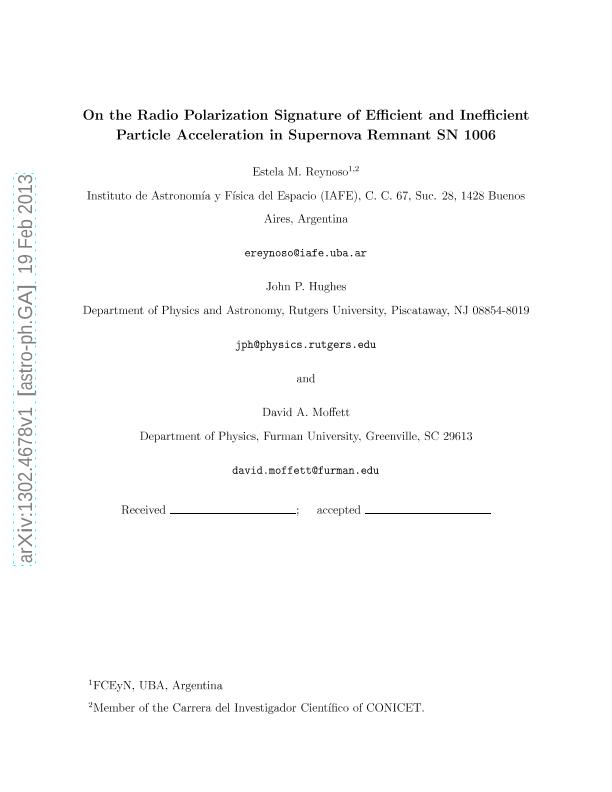Mostrar el registro sencillo del ítem
dc.contributor.author
Reynoso, Estela Marta

dc.contributor.author
Hughes, John P.
dc.contributor.author
Moffett, David A.
dc.date.available
2017-05-29T15:13:20Z
dc.date.issued
2013-04
dc.identifier.citation
Reynoso, Estela Marta; Hughes, John P.; Moffett, David A.; On the Radio Polarization Signature of Efficient and Inefficient Particle Acceleration in Supernova Remnant SN 1006; Iop Publishing; Astronomical Journal; 145; 4-2013; 104, 1-9
dc.identifier.issn
0004-6256
dc.identifier.uri
http://hdl.handle.net/11336/17056
dc.description.abstract
Radio polarization observations provide essential information on the degree of order and orientation of magnetic fields, which themselves play a key role in the particle acceleration processes that take place in supernova remnants (SNRs). Here we present a radio polarization study of SN 1006, based on combined Very Large Array and Australia Telescope Compact Array observations at 20 cm that resulted in sensitive images with an angular resolution of 10 arcsec. The fractional polarization in the two bright radio and X-ray lobes of the SNR is measured to be 0.17, while in the southeastern sector, where the radio and non-thermal X-ray emission are much weaker, the polarization fraction reaches a value of 0.6 ± 0.2, close to the theoretical limit of 0.7. We interpret this result as evidence of a disordered, turbulent magnetic field in the lobes, where particle acceleration is believed to be efficient, and a highly ordered field in the southeast, where the acceleration efficiency has been shown to be very low. Utilizing the frequency coverage of our observations, an average rotation measure of ~12 rad m-2 is determined from the combined data set, which is then used to obtain the intrinsic direction of the magnetic field vectors. While the orientation of magnetic field vectors across the SNR shell appear to be radial, a large fraction of the magnetic vectors lie parallel to the Galactic plane. Along the highly polarized southeastern rim, the field is aligned tangent to the shock, and therefore also nearly parallel to the Galactic plane. These results strongly suggest that the ambient field surrounding SN 1006 is aligned with this direction (i.e., from northeast to southwest) and that the bright lobes are due to a polar cap geometry. Our study establishes that the most efficient particle acceleration and generation of magnetic turbulence in SN 1006 is attained for shocks in which the magnetic field direction and shock normal are quasi-parallel, while inefficient acceleration and little to no generation of magnetic turbulence are obtained for the quasi-perpendicular case.
dc.format
application/pdf
dc.language.iso
eng
dc.publisher
Iop Publishing

dc.rights
info:eu-repo/semantics/openAccess
dc.rights.uri
https://creativecommons.org/licenses/by-nc-sa/2.5/ar/
dc.subject
Acceleration of Particles
dc.subject
Ism: Individual Objects: Sn 1006
dc.subject
Ism: Supernova Remnants
dc.subject
Magnetic Fields
dc.subject
Polarization
dc.subject.classification
Astronomía

dc.subject.classification
Ciencias Físicas

dc.subject.classification
CIENCIAS NATURALES Y EXACTAS

dc.title
On the Radio Polarization Signature of Efficient and Inefficient Particle Acceleration in Supernova Remnant SN 1006
dc.type
info:eu-repo/semantics/article
dc.type
info:ar-repo/semantics/artículo
dc.type
info:eu-repo/semantics/publishedVersion
dc.date.updated
2017-05-23T19:16:24Z
dc.journal.volume
145
dc.journal.pagination
104, 1-9
dc.journal.pais
Reino Unido

dc.journal.ciudad
Londres
dc.description.fil
Fil: Reynoso, Estela Marta. Consejo Nacional de Investigaciónes Científicas y Técnicas. Oficina de Coordinación Administrativa Ciudad Universitaria. Instituto de Astronomía y Física del Espacio. - Universidad de Buenos Aires. Facultad de Ciencias Exactas y Naturales. Instituto de Astronomía y Física del Espacio; Argentina
dc.description.fil
Fil: Hughes, John P.. Rutgers University; Estados Unidos
dc.description.fil
Fil: Moffett, David A.. Furman University; Estados Unidos
dc.journal.title
Astronomical Journal

dc.relation.alternativeid
info:eu-repo/semantics/altIdentifier/doi/http://dx.doi.org/10.1088/0004-6256/145/4/104
dc.relation.alternativeid
info:eu-repo/semantics/altIdentifier/url/http://iopscience.iop.org/article/10.1088/0004-6256/145/4/104
dc.relation.alternativeid
info:eu-repo/semantics/altIdentifier/arxiv/https://arxiv.org/abs/1302.4678
Archivos asociados
